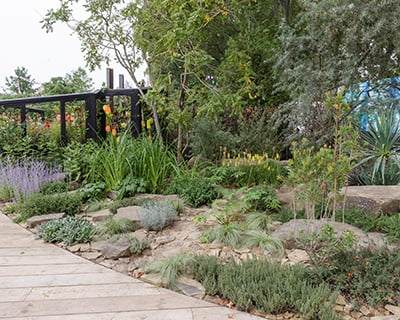RHS COP26 Garden: Adaptation
Here is a garden built for a hot dry future: but one that also suffers from periods of intense rainfall
This section represented a potential garden of the future with planting that copes with more extreme weather events – namely very hot and dry with periods of intense rain.
Like the earlier sections, the design circulated around the Universal Window Box through a series of areas that were adapted to increasing temperatures, ending in a storm tolerant garrigue – a form of Mediterranean scrubland. This forms a focal point of the area as a whole.
The desert and semi-desert areas demonstrate plantings that may be necessary to cope in the UK if the climate continues to warm unabated but with bouts of heavy rainfall. Here there were agaves, yuccas and Kniphofia (red-hot poker). A Koelreuteria paniculata (pride of India) was a particular feature, described by designer Marie-Louise Agius as a bomb-proof plant for climate change.
A drought-tolerant meadow designed for a less extreme future was filled with grasses and forbs which can deal with the occassional downpour.
The Mediterranean garrigue, which interrupted the other sections of this quarter, showcased how these low-growing plants from warmer climes such as Salvia officinalis, rock rose, thyme and rosemary can do well in the UK.

